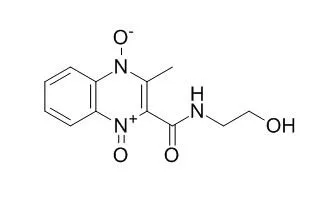| In vitro: |
| J Appl Toxicol. 2015 Jul;35(7):709-16. | | Reactive oxygen species-dependent JNK downregulated olaquindox-induced autophagy in HepG2 cells.[Pubmed: 25042557] | Autophagy plays an important role in response to intracellular and extracellular stress to sustain cell survival. However, dysregulated or excessive autophagy may lead to cell death, known as "type II programmed cell death," and it is closely associated with apoptosis. In our previous study, we proposed that Olaquindox induced apoptosis of HepG2 cells through a caspase-9 dependent mitochondrial pathway.
METHODS AND RESULTS:
In this study, we investigated autophagy induced by Olaquindox and explored the crosstalk between apoptosis and autophagy in Olaquindox-treated HepG2 cells. Olaquindox-induced autophagy was demonstrated by the accumulation of monodansylcadervarine, as well as elevated expression of autophagy-related MAP-LC3 and Beclin 1 proteins. The autophagy inhibitor 3-methyladenine significantly increased the apoptotic rate induced by Olaquindox, which was correlated with increased ratio of Bax/Bcl-2. The further studies showed that Olaquindox increased the levels of reactive oxygen species (ROS), and antioxidant N-acetyl-L-cysteine (NAC) effectively blocked the accumulation of ROS but failed to block autophagy. Moreover, Olaquindox induced the activation of c-Jun N-terminal protein kinase (JNK), and JNK inhibitor SP600125 failed to block autophagy. Instead, Olaquindox-induced autophagy was enhanced by NAC or SP600125. Meanwhile, JNK activation was remarkably blocked by NAC, indicating that ROS may be the upstream signaling molecules of JNK activation and involved in the negative regulation of Olaquindox-induced autophagy.
CONCLUSIONS:
These results suggest that Olaquindox induces autophagy in HepG2 cells and that Olaquindox-induced apoptosis can be enhanced by 3-methyladenine. Olaquindox-induced autophagy in HepG2 cells is upregulated by Beclin 1 but downregulated by ROS-dependent JNK. | | J Sci Food Agric. 2012 Oct;92(13):2696-702. | | Development of an on-line molecularly imprinted chemiluminescence sensor for determination of trace olaquindox in chick feeds.[Pubmed: 22505192] | Olaquindox, as one of the antimicrobial growth accelerants, is usually used in livestock production to improve feed efficiency. Due to health concerns over possible carcinogenic, mutagenic and photoallergenic effects of Olaquindox on animals, the development of simple, rapid and sensitive analytical method for determination of Olaquindox is crucial and necessary.
METHODS AND RESULTS:
In this study, a surface molecularly imprinted polymer was prepared by a molecular imprinting technique in combination with a sol-gel process using activated silica gel as a support material. This imprinted material exhibited with good recognition and selective ability, and fast adsorption-desorption dynamics toward Olaquindox. Using it as the recognition element, a new on-line molecularly imprinted solid phase extraction coupled with chemiluminescence sensor for the determination of Olaquindox was developed. The factors affecting preconcentration of the analytes and sensitivity of the method were all investigated. Under the optimal condition, the linear range of the calibration graph was between 2 × 10(-8) and 1 × 10(-6) g mL(-1) , and the detection limit of this method was 7 × 10(-9) g mL(-1) . The blank chick feed samples spiked with Olaquindox at 0.3, 0.9 and 1.5 μg g(-1) levels were extracted and determined by this presented method with recoveries ranging from 87% to 94%. This method was validated by high-performance liquid chromatography and the results correlated well with those obtained by both methods. Moreover, this method was quantitatively analysed with two contaminated chick feed samples.
CONCLUSIONS:
This study will provide a sensitive and fast method for the monitoring of Olaquindox residues in foods. |
|






 Cell. 2018 Jan 11;172(1-2):249-261.e12. doi: 10.1016/j.cell.2017.12.019.IF=36.216(2019)
Cell. 2018 Jan 11;172(1-2):249-261.e12. doi: 10.1016/j.cell.2017.12.019.IF=36.216(2019) Cell Metab. 2020 Mar 3;31(3):534-548.e5. doi: 10.1016/j.cmet.2020.01.002.IF=22.415(2019)
Cell Metab. 2020 Mar 3;31(3):534-548.e5. doi: 10.1016/j.cmet.2020.01.002.IF=22.415(2019) Mol Cell. 2017 Nov 16;68(4):673-685.e6. doi: 10.1016/j.molcel.2017.10.022.IF=14.548(2019)
Mol Cell. 2017 Nov 16;68(4):673-685.e6. doi: 10.1016/j.molcel.2017.10.022.IF=14.548(2019)